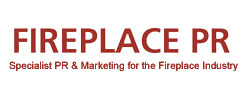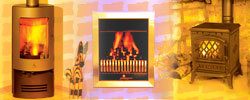 |
Fireplace PR, PO Box 583,
High Wycombe, HP15 6XT. Tel 01494 711430.
email: phassocs@lineone.net
|

|
|
|
Q1. I’ve been told that, to use a stove in my chimney,
I really need it to be lined. Is there any way around this is it appears
to be really expensive? Q1. I’ve been told that, to use a stove in my chimney, I really need it to be lined. Is there any way around this as it appears to be really expensive? A. Although some modern chimneys do not require lining it really is advisable in all period properties as the material used to line chimneys up to the middle of the Twentieth century, known as parging, tends to break down with age and if there has been a chimney fire. This can leak flue gases into upstairs rooms with possible disastrous consequences. There a various ways to line a flue, some of them less expensive than others, and your local member of the National Association of Chimney Engineers can advise you. Phone them on 0800 0924019 or visit their web site at www.nace.org.uk. Q2. I’m currently having work done in my house by builder who has offered to modify my fireplace. Does he have the background knowledge to undertake this safely? A. The Building Regulations as they relate to fireplaces changed in April 2002 and the new version of Document J requires that work is either done by a ‘competent’ person or Building Regulations approval are sought from your local authority. The Document explains that competent means an expert certified by one of three bodies – CORGI for gas work, HETAS for solid fuel or OFTEC for oil. If your builder does not have a certificate from one of these bodies the National Fireplace Association can give you the name of a local approved engineer. Phone them on 0121 200 1310 or via their web site at www.nfa.org.uk. Remember it is your responsibility to comply with building regulations, not your builders. Q3. If I already have central heating why do I need a fire in my living room? A. Central Heating is a phenomenon of the last forty years. Of course, central heating has done away with the need to warm each room in this way but many owners of period properties are keen to recreate the ambiance that only a fire in fireplace can create. Coupled with this is the desire to create a centre point for a living room, a glowing fire that will look the part and warm on those chilly autumn nights. Q4. I’m really in a quandary about which sort of fire to use in my Edwardian-built house. Can you offer any advice? A. The fire or stove that you choose for your period property should reflect two factors. It needs to be in keeping with the period of the property and you need to like it! Nothing looks more out of place than a contemporary styled gas fire in an imposing Adam surround. Research in your local library and in Period design books to get an idea of what the fireplace should look like and make your choices based on this. For many properties, the original fuel would have been coal or wood as gas fires were only produced from c. 1880 and electric designs from around 1900. However, it is quite acceptable to use an alternative fuel if the aesthetics of the fire or stove itself are correct. Solid fuel - coal, smokeless fuels and wood – will create the look of the original house. However, you must be aware that many of the UK’s towns and cities are in smoke control areas where it is permissible to burn smokeless fuels like Coalite but not wood or house coal. Your local environmental health department can advise on smoke control legislation. In towns it may be more practical to look for a gas alternative and many open fire designs, previously intended for solid fuel use, are available with gas burners. Gas fires dominated the market in middle class suburban homes from 1920 onwards; so these fires are the ideal designs for houses built in this era. Unfortunately, nobody makes the type of gas fire used in the 1930/1940s and you may have to make do with a modern living flame alternative. Q5. I like the look of heating
stoves which I constantly see in home interest magazines. Are they suitable
for my 1930s semi? Q6. The choice for independent
living room heating appears to be between open fires and stoves. What
are the pros and cons? Q7. How do I know if my chimney is still in working order? A. Popular folklore has it that up to ¼ of all chimneys in the UK housing stock are defective. So it is important to check that the flue in your listed property works properly and efficiently. Firstly it must have a good pull – smoke created in the fireplace must be drawn up the chimney. Factors which may cause problems are exterior chimneys on cold north walls, flues that do not clear the roof line of the house and situations where wind flow across the chimney pot is hampered by nearby trees, buildings, hillsides, etc. If the flue does not pull, it may be necessary to extend it, change is termination (pot or cowl) or even add a fan onto it. It is also important that the flue does not leak burnt products of combustion into the rooms through which it runs. A smoke match (and a keen nose in each room) can test this. If you have any worry that a flue is leaking, get a professional to inspect it. The National Association of Chimney Engineers (NACE) are experienced in chimneys and in relining them. Tel: 0800 094019. To inspect the chimney the engineer can use a small camera, which looks at the condition of the parging (lining) and at the mid feathers or withes - the bricks that divide multiple flues in one chimneystack. Lining a leaky flue can be achieved using various methods – in situ concrete liner, flexible metal liner or flue blocks and the NACE engineer can advise on suitability.
A. If you have a a chimney, is it intact and does it work properly? Have you got a mains gas supply? Do you really want heat or primarily good looks? What sort of styling suits your home? Do you want an open fire or a stove? Are some fires cheaper to operate? What is your budget? Where to go for advice? I’ve heard about flueless products. What are they and are
they safe? I haven’t got much space in my living room. What are the
choices? Are there particular designs suitable for the elderly or disabled? What’s new? |
||||||||||||||||||||||||||||||||||||||||||||||||||||||||||||||||||||||||||||||||||||||||||||||||||||
| Fireplace PR, PO Box 583, High Wycombe, HP15 6XT. Tel 01494 711430. e-mail: phassocs@lineone.net |